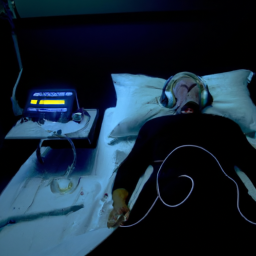Imagine a world where sound is muffled and your ears constantly feel clogged, making it difficult to hear and communicate effectively. This is the reality for those suffering from Eustachian Tube Dysfunction (ETD).
The Eustachian tubes, located in the middle ear, play a crucial role in regulating pressure and draining fluids. When these tubes become blocked or fail to function properly, it can lead to a range of uncomfortable symptoms.
ETD can be caused by various factors, such as allergies, sinus infections, or even a common cold. Recognizing the signs, which may include ear pain, muffled hearing, and a feeling of fullness in the ears, is crucial for prompt diagnosis and treatment.
Fortunately, there are effective treatment options available, including medications, nasal sprays, and in severe cases, surgical interventions. By understanding the causes, symptoms, and treatment options for ETD, you can regain control over your hearing health and improve your overall quality of life.
Key Takeaways
- Eustachian Tube Dysfunction (ETD) is a condition where the Eustachian tubes in the middle ear become blocked or fail to function properly.
- Common causes of ETD include allergies, sinus infections, and colds.
- Symptoms of ETD include ear pain, muffled hearing, and a feeling of fullness in the ears.
- Treatment options for ETD include nasal decongestants, antihistamines, ear tube placement, and autoinflation techniques.
Anatomy and Function of the Eustachian Tubes
The Eustachian tubes, like tiny tunnels, connect the ears to the back of the throat. They play a crucial role in equalizing pressure and maintaining proper functioning of the middle ear. These tubes are lined with a thin layer of mucous membrane and are made up of cartilage and bone. Their structure allows them to open and close, regulating the flow of air and fluids between the middle ear and the throat.
The Eustachian tubes also help to drain any excess fluid or mucus from the middle ear, preventing the build-up of pressure and reducing the risk of infection. Understanding the anatomy and function of the Eustachian tubes is essential in comprehending the common causes of Eustachian tube dysfunction, such as allergies, sinus infections, and changes in altitude.
Common Causes of Eustachian Tube Dysfunction
One of the most common reasons for ETD is when the tubes become blocked or clogged. This blockage can occur due to various causes, including allergies, sinus infections, colds, or changes in air pressure, such as during air travel or scuba diving.
Other factors that can contribute to the blockage of the eustachian tubes include smoking, excessive mucus production, or anatomical abnormalities. Individuals who’ve a history of frequent respiratory infections, allergies, or sinus problems are more likely to experience eustachian tube dysfunction.
Additionally, children’re more susceptible to this condition due to their smaller and narrower eustachian tubes. Understanding the causes of blockage and identifying the risk factors associated with eustachian tube dysfunction’s crucial in recognizing the symptoms that may arise.
Recognizing the Symptoms of Eustachian Tube Dysfunction
Identifying the symptoms of Eustachian tube dysfunction is crucial for understanding the impact it can have on your daily life. Recognizing symptoms such as ear pain, muffled hearing, and a feeling of fullness or pressure in the ears is key to seeking appropriate treatment.
Other common symptoms include tinnitus (ringing in the ears), dizziness, and difficulty equalizing ear pressure during activities like flying or diving. It is important to note that these symptoms can also be indicative of other ear conditions, so it’s essential to consult a healthcare professional for an accurate diagnosis.
Diagnostic methods for Eustachian tube dysfunction may include a physical examination of the ears, a hearing test, and imaging tests such as a tympanogram or CT scan. Understanding the symptoms and seeking a proper diagnosis is the first step towards managing Eustachian tube dysfunction effectively.
In the next section, we’ll discuss the diagnostic methods in more detail.
Diagnosing Eustachian Tube Dysfunction
When you suspect you may have Eustachian tube dysfunction, a healthcare professional will use various diagnostic techniques to accurately determine the cause of your ear discomfort. Some common methods used include:
-
Otoscopy: Your healthcare provider will use a specialized tool called an otoscope to examine your ear canal and eardrum. This allows them to look for any signs of inflammation, blockages, or other abnormalities.
-
Tympanometry: This test measures the movement of your eardrum in response to changes in air pressure. It can help determine if there’s any blockage or dysfunction in the Eustachian tube.
-
Audiometry: This test assesses your hearing ability and can help identify any hearing loss that may be associated with Eustachian tube dysfunction.
Diagnosing Eustachian tube dysfunction can be challenging as the symptoms can be similar to other conditions such as ear infections or allergies. However, with the help of these diagnostic methods, healthcare professionals can accurately diagnose the underlying cause of your ear discomfort.
Moving forward, let’s discuss the treatment options for Eustachian tube dysfunction.
Treatment Options for Eustachian Tube Dysfunction
To treat Eustachian Tube Dysfunction, there are several options available to you. One option is to use nasal decongestants and antihistamines, which can help reduce inflammation and congestion in the nasal passages.
Another option is ear tube placement, also known as tympanostomy, where small tubes are inserted into the eardrums to help equalize pressure.
Lastly, autoinflation techniques such as the Valsalva maneuver can be used to open up the Eustachian tubes by blowing air through the nose while pinching the nostrils closed.
Nasal decongestants and antihistamines
Using nasal decongestants and antihistamines can provide immediate relief, making you feel like a weight has been lifted off your congested chest. These medications work by reducing inflammation and swelling in the nasal passages, allowing for better airflow and relieving the symptoms of eustachian tube dysfunction. Here are four benefits of using nasal decongestants and antihistamines:
-
Decreased congestion: Nasal decongestants can help clear the blockage in the eustachian tube, allowing for easier equalization of pressure.
-
Reduced ear pain: By reducing inflammation, antihistamines can help alleviate the pain associated with eustachian tube dysfunction.
-
Improved hearing: Clearing the congestion can improve hearing by allowing sound waves to travel more freely.
-
Faster recovery: Using nasal decongestants and antihistamines can help speed up the healing process and reduce the duration of symptoms.
Transitioning into the subsequent section about ear tube placement (tympanostomy), it’s important to explore further treatment options when nasal decongestants and antihistamines fail to provide long-term relief.
Ear tube placement (tympanostomy)
Ear tube placement, also known as tympanostomy, is a surgical procedure that can provide long-term relief for chronic ear problems. During the procedure, a small tube is inserted into the eardrum to allow for proper drainage and ventilation of the middle ear. This can help relieve symptoms such as ear pain, hearing loss, and recurrent ear infections.
While ear tube placement is generally safe and effective, there can be complications. These may include infection, scarring, blockage of the tubes, and persistent ear drainage. It’s important to discuss the potential risks and benefits with your doctor before deciding on this procedure.
In the next section, we’ll explore autoinflation techniques, such as the valsalva maneuver, which can also help manage eustachian tube dysfunction.
Autoinflation techniques (such as the Valsalva maneuver)
One way to help relieve pressure in your ears is by trying autoinflation techniques like the Valsalva maneuver. Autoinflation techniques are simple exercises that can be done to open up the eustachian tubes and allow air to flow in and out, equalizing the pressure in your ears.
The Valsalva maneuver involves closing your mouth and pinching your nose shut while gently blowing air out through your nose. This creates pressure in the back of your throat, which can help to open up the eustachian tubes.
It’s important to note that while autoinflation techniques can provide temporary relief, they may not be effective for everyone. In some cases, surgical interventions such as ear tube placement may be necessary to address eustachian tube dysfunction.
Now let’s move on to the next section about the prevention and management of eustachian tube dysfunction.
Prevention and Management of Eustachian Tube Dysfunction
To really ensure that you don’t find any relief from your constant ear pain and pressure, just ignore any advice about prevention and management of eustachian tube dysfunction. Taking proactive steps can greatly improve your symptoms and overall quality of life.
Here are some prevention techniques and lifestyle changes that can help:
-
Maintain good hygiene: Regularly clean your ears to prevent wax buildup, which can contribute to eustachian tube dysfunction.
-
Stay hydrated: Proper hydration keeps the mucus in your ears thin and flowing, reducing the risk of blockages.
-
Avoid smoking and exposure to secondhand smoke: Smoking can irritate the eustachian tubes, leading to dysfunction.
-
Practice good allergy management: Allergies can cause inflammation in the nasal passages, which can affect the eustachian tubes. Take necessary steps to control your allergies.
-
Manage stress: Stress can worsen symptoms, so finding healthy ways to manage stress can be beneficial.
Incorporating these prevention techniques and lifestyle changes can help reduce the frequency and severity of eustachian tube dysfunction symptoms.
Frequently Asked Questions
Can Eustachian tube dysfunction lead to permanent hearing loss?
Eustachian tube dysfunction can potentially lead to permanent hearing loss if left untreated. When the Eustachian tube isn’t functioning properly, it can cause a buildup of fluid and pressure in the middle ear. This can lead to damage and loss of hearing. Medical treatments like surgery or medications may be necessary in severe cases. However, there are also natural remedies that can help alleviate symptoms and promote Eustachian tube health. These include nasal irrigation, steam inhalation, and chewing gum.
Are there any natural remedies or home remedies that can help alleviate Eustachian tube dysfunction symptoms?
Looking for a natural way to soothe your eustachian tube dysfunction symptoms? You’re in luck! There are some home remedies and natural remedies that may bring you relief.
Homeopathic treatments, such as herbal remedies and essential oils, have been used by many to alleviate symptoms.
Additionally, steam inhalation, warm compresses, and nasal irrigation can help open up the eustachian tubes and promote better drainage.
Give these natural options a try and see if they work for you!
Is there a specific age group that is more prone to developing Eustachian tube dysfunction?
A specific age group that is more prone to developing eustachian tube dysfunction is children. Due to their immature anatomy and developing immune systems, children are more susceptible to this condition.
The eustachian tubes in children are shorter and more horizontally positioned, making it easier for them to become blocked. Additionally, common childhood illnesses such as colds and allergies can further increase the risk of eustachian tube dysfunction.
Therefore, it’s important to be aware of this condition in children and seek appropriate medical attention if symptoms arise.
Can allergies or sinus infections contribute to Eustachian tube dysfunction?
Yes, allergies and sinus infections can contribute to eustachian tube dysfunction. When you have allergies or a sinus infection, the lining of your nose and throat can become swollen and produce excess mucus. This can block the eustachian tubes, preventing them from equalizing pressure in the middle ear.
Common treatments for eustachian tube dysfunction include using decongestants, nasal sprays, and antihistamines to reduce inflammation and clear the tubes.
Are there any long-term complications associated with untreated Eustachian tube dysfunction?
Untreated eustachian tube dysfunction can lead to long-term complications that can significantly impact your health. In fact, studies have shown that up to 40% of individuals with untreated dysfunction may experience chronic hearing loss or tinnitus.
The impact of leaving this condition untreated can also extend to your mental well-being, as it may cause feelings of frustration, isolation, and decreased quality of life.
It’s crucial to seek treatment to prevent these potential long-term complications.
Conclusion
In conclusion, you now have a comprehensive understanding of eustachian tube dysfunction. By recognizing the symptoms and seeking a proper diagnosis, you can embark on the journey towards effective treatment.
Whether it’s through medication, nasal sprays, or surgical interventions, there are options available to alleviate your discomfort. Remember, prevention and management are key in maintaining healthy eustachian tubes. So, stay vigilant and take the necessary steps to ensure your ears remain in optimal condition.
Your future awaits, free from the constraints of eustachian tube dysfunction.




